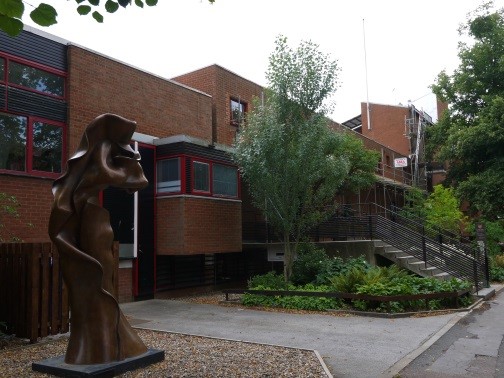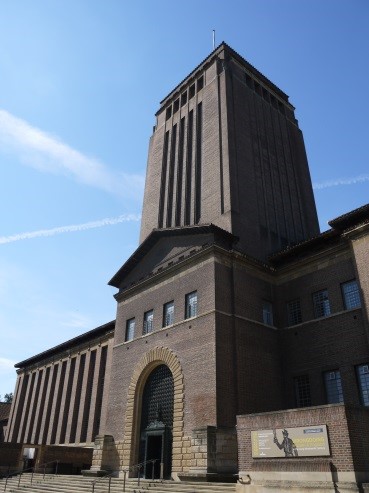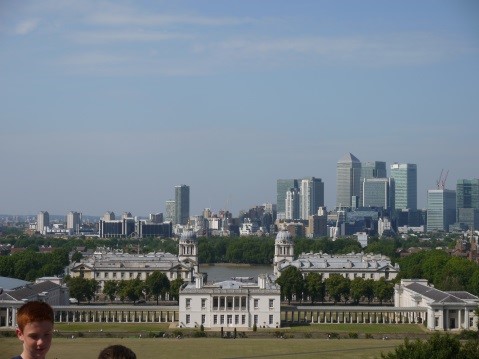- HOME
- About AIS
- Study Abroad Program
- Clare Hall, University of Cambridge Summer Visiting Student Program Report
Clare Hall, University of Cambridge Summer Visiting Student Program Report
2013 Academic Year
Shin Sato: Doctoral Student, The University of Tokyo Graduate Schools for Law and Politic
50 miles north-northeast of London, Cambridge is a quiet university town. Venerable college buildings lie along River Cam, and there is an urban district with the old town scenery on the east shore, while there are college grounds on the west shore. Clare Hall stands at the west end of the college grounds, 15 to 20 minutes' walk from the city center. Clare Hall, established in 1966, is an exceptionally new college compared with other colleges in the University of Cambridge, and so its buildings and environment are clean and comfortable. I enjoyed my stay here for one month for my research on ''Space and Politics''.
I had heard about the college culture of Oxbridge that members of a college can enjoy the benefit of communicating with many other teachers and students from different majors but need to dine formally as in the world of Harry Potter. However, the dining hall of this new college had a free and easy atmosphere with huge panes of glass, and the members took their meals very friendly. On the next day of my arrival, Mrs. Irene Hills kindly set a lunch for me with a senior tutor of the college, Professor Iain Black, and another visiting student from Germany. A three-course lunch with soup, main and dessert, was simple but suitable for chatting over.
It turned out that Professor Black, whose major is geographies of money, banking and finance, happened to be interested in architectures of economic centers, especially City of London, so we, together with his son, had lunch twice after that. We discussed various matters, from how we should explain the difference between the scale of architectures and that of city plans to how we should think about the relationship between space and (political and economic) powers. Getting useful information about references from him, I walked five minutes to the University Library. Each college has its own library, and so does each faculty, but the University Library, designed by Giles Gilbert Scott, overwhelms those libraries. This early 1930s' design with a dominating tower in its center is said to resemble one of his masterpieces, the Bankside Power Plant (present Tate Modern), and it seems to me that it also resembles the Nagoya City Hall which was designed by Kingo Hirabayashi in the early 1930s.
Walking southwards along the river, you can see the Sedgwick Site. Surrounded by college grounds, this university site holds many faculty facilities. Buildings of these facilities are, unlike surrounding antique college buildings, rather modern in style, which makes this site look like a toy box. Here, we had classes of the Interdisciplinary Summer School (Term II). I joined two classes. In the first ''Power and politics in Britain today'' class by Mr. Richard Yates, the lecturer frankly explained the political systems of contemporary Britain to the students, most of whom were undergraduate students from the Continent. On the other hand, the second class titled ''Historic houses and gardens in England and Scotland'' had many aged students mostly from US and UK who enjoy gardening in their own gardens. Mrs. Caroline Holmes showed us a lot of designs and pictures and explained histories and characteristics of the houses and the gardens with immense knowledge. Although I knew next to nothing about the names of plants for gardens, yet the class was a great experience for me because it provided me with one standard by which I read Japanese houses and gardens. In addition, I had opportunities to submit essays to the lecturers of these classes, one on the British monarchy for the Yates' class, and the other for the Holmes' class where I compared political houses of Japan and those of Britain. Writing essays proved fruitful not only because I could learn a lot through writing them but also because I could discuss the related subjects with the lecturers more closely.
Although I was busy writing these essays, I tried to visit as many architectures and gardens as possible near London. For example, the Hatfield House is one of the most famous power houses in England. It is where Elizabeth I was born, and her supporter, Robert Cecil, had a great influence on the political scenes of the day. After that, this historical house was used by powerful successors, such as the 3rd Marquess of Salisbury. As architecture, this house is full of ornaments including portraits of their monarchs and families, which clearly shows their historical legitimacy as a powerful family. When I later visited the Windsor Castle, I noticed this castle was similarly legitimated by the emblems of his/her subjects, in place of portraits.
In contrast to this Britons' attachment to ornaments, John Soane's architectures, such as the Bank of England, are famous for their simplicity along with his passion for Roman culture (you can see his obsession for Roman culture in his museum). Christopher Wren was between them, sometimes using paintings on the walls and ceilings of his architectures to combine majestic scale with splendor. For example, the paintings on the ceiling of the St. Paul Cathedral delude us into thinking that the ceiling is the outer dome, although they are in fact on the inner dome. In the case of the Old Royal Naval College in Greenwich, Wren realized a greater plan by making the best use of the Queen's House next to the district, and at the same time added splendor to the inside of the building by painting the walls and ceilings. These tricks nearly end up with ostentation, but he succeeded in doing that anyway, which has led him to be called a master.
Back to Cambridge on the last day of the stay, I was eating a Cambridge burnt cream, looking at the towers of King's College under the blue sky. There, I remembered all the people and architectures that I met during my stay, and thought this city amazing. Cambridge is filled with old buildings. However, people in this city do not intend to preserve those buildings just for sightseeing. Rather, those citizens of this university town accept multiculturalization and internationalization, and they cherish the modest atmosphere of this city. We, at least Japanese, must have a lot of things to learn from this city and its people.
I would like to thank all the people who supported my stay and, most of all, the RCAST, which offered me this valuable experience.

CLARE HALL

The University Library

Greenwich - The Old Royal Naval College and The Queen's House




